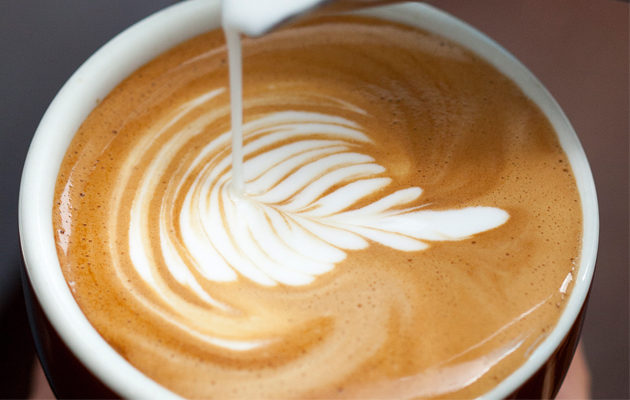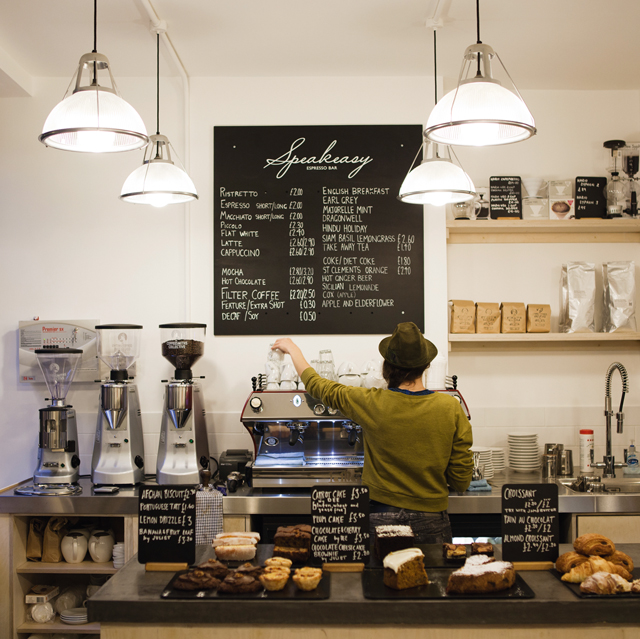Where to get the best coffee in Britain
Coffee is now being treated with the same discrimination previously reserved for wine.

What sort of coffee are you sipping as you read this issue? Does it sparkle on the palate like a summer pudding or is it darker, earthier, with a suggestion of leaf mould? Is it perfumed like an aromatherapy oil or as rich as chocolate? The answer could well be none of the above, because most coffee is made from a blend of beans, which suppresses the constituent parts, but brace yourself for a change. Coffee is joining the growing list of products beer, olive oil, anything from a farmer’s market that are losing their generic quality and being treated with the discrimination previously reserved for wine.
At the forefront of the revolution is Tim Ridley, a young Australian whose wittily named coffee shop, the Department of Coffee and Social Affairs (http://departmentofcoffee.com), stands on Leather Lane in Clerkenwell, EC1, and which, on the day I visit, pullulates with life. My nose has already been torn in a dozen different directions by the smell of food being sizzled in the market before I join Tim at a table outside the shop to taste a couple of his brews: Summer Cup and the Earl’s Mistress (the names are as tantalising as the aromas).

I can see what he means by them, too. Summer Cup does indeed taste of berries and there are distinct citrus notes to the Earl’s Mistress a hint of bergamot, in the manner of an Earl Grey tea. But this isn’t coffee as I know it. My morning cup is an ink-black substance, with the explosive capacity of a field mortar. Tim’s offering is so refined that it’s practically another drink. I’m not sure it would have the same physiological properties in terms of kick-starting the system, but then it doesn’t aim to. This is coffee to be sipped and savoured. In making it, Tim is as precise in measurements and temperatures as any one of the jewellers in nearby Hatton Garden.
This development could be construed as a return to the roots of the drink, when it was a curiosity, appreciated by connoisseurs, not least for its supposed medicinal properties. The first Englishman to write about coffee was William Biddulph, a clergyman, who visited Aleppo in 1600. The Turks, he observed in a letter, enjoyed ‘Coffa, which is a blacke kinde of drinke, made of a kind of Pulse like Pease… they drinke it as hot as they can suffer it’. But even they hadn’t been drinking coffee for very long.
Exactly half a century after Biddulph’s letter, in 1650, the first coffee house opened in Britain. It was in Oxford, the centre of a learned community, open to ideas from overseas, and its proprietor was Jewish. Two years later, a ‘cuphye-house or a Turkish as it were ale-house’ clearly still a perplexing notion opened in London. Although ‘somewhat hot and unpleasant’, coffee was ‘a good after relish and caused breaking of wind in abundance’ according to Samuel Hartlib in Ephemerides.
By the end of the 17th century, the coffee house had evolved into a familiar form of meeting place. By modern standards, the coffee was watery, the beans being stewed in a large vat over a fire. They became centres of news, if not always conversation. The Russian Karamzin records dropping into ‘a number of coffeehouses only to find 20 or 30 men sitting around in deep silence, reading newspapers, and drinking Port. You are lucky if, in the course of 10 minutes, you hear three words. And what are they? “Your health, gentlemen!”’. Clearly, the social practices of the gentleman’s club had been formed many of the earliest clubs, including White’s, Boodle’s and the Reform, grew out of coffee houses.
Presumably, not all were silent; ‘coffeehousing’ is a word still used on the hunting field to indicate unnecessary chatter. Strangely, the Oxford English Dictionary doesn’t record a use before 1861, by which time one would have thought coffee houses had become rather old-fashioned, their place in the public’s affection having been taken by chop houses.
Exquisite houses, the beauty of Nature, and how to get the most from your life, straight to your inbox.
In the 20th century, coffee became a badge of sophistication, prepared by sometimes recherché methods. James Bond used an American Chemex apparatus: essentially, a filter in an hour-glass shaped vessel. Ordinary householders relied on percolators, which kept the coffee hot but undrinkable.
Coffee shops started appearing in Soho and Chelsea during the 1950s. Their decor reflected the cheerful Modernism of the Festival of Britain. For the rest of the UK, a trip to Italy, with its bars and gleaming espresso machines, was a revelation. Then came Starbucks. Fresh coffee became a cliché of the high street. Last year, the sale of teabags in the UK fell by 6%. As commentators were quick to observe, the cuppa is being replaced by the cappuccino.
Coffee experts now believe that Britain is experiencing a second wave of appreciation, as consumers seek a subtler product. The pioneer of this movement was Monmouth Coffee Company in Covent Garden (www.monmouthcoffee.co.uk), which began roasting beans from single farms, estates and co-operatives in 1978.
Over the past decade, more specialist roasters have come on the scene, buying from brokers who are keen to explore the flavours that can be obtained from small producers around the world from Brazil to Burundi, Ethiopia to El Salvador. ‘Really, the movement has only just begun when you compare it to wine,’ says Alec Oyhenart of the coffee broker Nordic Approach. ‘Entire countries that are unknown to the public, such as Rwanda, are coming on-stream. We’re not even close to having a grand cru classification.’
Britain is about to lose the skills of Ben Presland: the news that he has sold his house, prior to returning to his native Australia (there are a lot of Australians, I discover, in the coffee vanguard), comes through as I visit his roastery in Balham. Ben himself is a shorts-wearing, ginger-haired enthusiast, whose beans you may already have tasted if you’ve had coffee at the Tate: its cafes make a lot of coffee and he supplies them with the best.
Green coffee beans, from one of the hessian sacks around the shed, look and smell rather like feed pellets. There is nothing of the come-down-to-breakfast smell that the world associates with coffee. That’s only acquired with roasting: a process that sees the beans behave like popcorn. A thousand little explosions can be heard while the oven ‘in essence, a barbecue with a spinning drum’ rotates.
‘What I try to do,’ Ben explains, ‘is to maintain what’s in the green coffee.’ Heavy roasting, Italian-style, tends to burn the oils and gases out of the beans and they are what give the resulting brew flavour. He likens his art less to alchemy than ‘cooking a steak’. We watch the beans jiggling in the drum. ‘There are two cracks to roasting coffee. We get nearly to the second crack any more and they’re burnt.’
Once roasted, the beans go on their way, perhaps to a coffee house such as Tim’s. It’s now down to the art of the individual coffee maker to complete the journey to the cup. Size of ground, length of contact time with the water, the type of mechanism being used (filter is best): all will affect the quality of the result. Tim actually offers classes for the less confident. Too much information? Do you know, I might just go along.